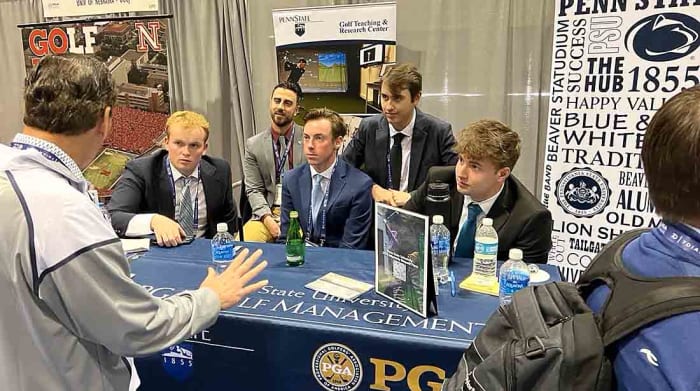ORLANDO, FLA.—To the arguments, pro or con, for certain individuals entering the World Golf Hall of Fame, I offer a dark horse candidate: Dr. Robert Ewigleben. President of Michigan’s Ferris State University from 1971 to 1984, Ewigleben (pronounced AY-wuh-glay-bin) raced sailboats, played competitive bridge, flew airplanes and, yes, was a scratch golfer. But his real contribution to the greengrass way of life was his founding, in 1975, of the world’s first professional golf management degree program. Four decades later, roughly 1,900 Ferris State PGM graduates manage country clubs, give golf lessons, operate pro shops, run resorts, and lead tech startups around the world. Ewigleben, who died in 2019 at the age of 91, may be the modern golf economy’s founding father.
Never heard of him? Me neither.
Until yesterday, when I wandered into an area of the Orange Country Convention Center called The Career Zone. This back-wall neighborhood of fresh-faced college kids and world-weary golf executives is where PGA Show veterans go to find talent for their golf mills. This year, 18 universities exhibited under a “PGM Universities” banner, the typical booth being a table for brochures, an informational backboard (“Festus College, Home of the Sardonic Sod Cutters”) and from two to five students in business attire, each more wholesome-looking than the last.
“Head professionals come by looking for employees,” said Kevin Odell, a University of Maryland Eastern Shore PGM alum currently serving as director of his school’s Entrepreneurship and Innovation Center. It’s a familiar ritual for Odell, who wants to be a golf club general manager. “I was playing high school golf when University reps started showing up at my tournaments,” he said. Looking for the next Tiger Woods? Nope. Looking for Callaway Golf’s sales and marketing director, circa 2038. “What’s attractive about Eastern Shore is the ability to play on Division I men’s and women’s teams. We’re also the only historically black University with a PGM program.”
No one seemed too disturbed by press reports characterizing “club pro” as one of the worst jobs in the world—a thankless grind of 80-hour weeks under the unforgiving gaze of club members, with little time to teach and virtually no opportunity to play the game they used to love. (The kids at the Clemson University stand were the only ones to hint at trouble in paradise. “Our school has discontinued its program,” one of them said, “so now we’re just networking and finding jobs.”)
The positivity could be blamed on youth and idealism. “I grew up on a small-town golf course and had a green in my backyard,” said Nebraska’s Ian Brandt, a tall, slender youngster with a winning smile. “I had Division II offers as a player, but it wasn’t something I saw as a future.” The Cornhusker at his side, Chase Largen, also started with the game, but soon realized—and here he grinned—”that I wasn’t as good as I thought.” And why be down, with entry-level openings aplenty and average salaries for full-time head pros inching above $100,000?

On the lookout for talent: Troon’s Ashley Darling and Katherine Sweeney.
John Garrity/Sports Illustrated
“This is the first time we’ve had a booth at the PGA Show,” said Ashley Darling, a senior recruiter for industry giant Troon Golf, which manages more than 725 courses around the world. Troon held a “PGM Welcome Event” on Tuesday, educating 180 students about internships and career opportunities. “We have 32,000 employees and about 3,000 jobs on our career board at any given time,” Darling said. “These kids are the next wave in the golf industry, and we want to be a part of that.”
Internships are required components of the PGM programs. Students serve three, six, and seven-month internships on their way to a bachelor of science degree and, if they pass their tests, PGA membership. At the Penn State booth, a chuffed Charlie Gendron said, “I’ll be doing my level 2 internship this summer at the Country Club of Brookline,” clearly aware that the storied US Open and Ryder Cup venue is a plum assignment. Nebraska senior Paul Deeter seemed equally pleased, having learned that his level 3 internship at Denver’s Columbine Country Club would lead to a permanent position there.
“Moving around, you learn so much,” said Ferris State sophomore Owen Flaherty. “Some of us had the ability to play college golf—you need to have an 8 handicap or better to get in the program—but most of us are just in love with golf. We love teaching or want to be directors of golf or want to go corporate and work for a manufacturer.” He beamed. “I want to run a golf course.”
Standing apart from the fresh-faced enthusiasts, at a tall table in the middle of the Career Zone, was a gray-haired man in a black suit—a USGA volunteer, but a Fed in real life. Robert Blaney is the Phoenix, Ariz., district director for the United States Small Business Administration, so he probably knew of the PGA of America’s data showing PGM University enrollments falling roughly fifty percent in the past two decades, to less than 5,000 students. “The programs are still very important,” he insisted. “Pros used to get into the PGA because they could play golf. But golf is a business, and your golf shop has to be a profit center. And for that”—he stared across the floor at the Ferris State booth—”you need a business education.”
Shades of Robert Ewigleben.
.
